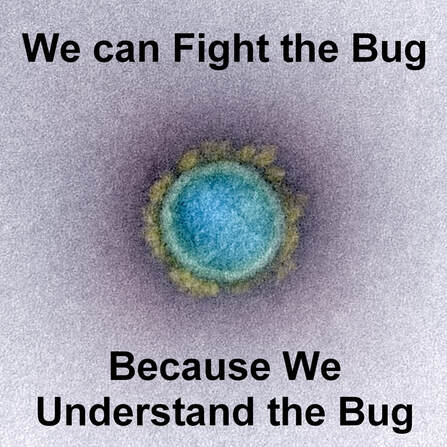 Starship Troopers Starship Troopers The American writer, Robert Heinlein, wrote a controversial military science fiction novel in 1959 entitled, Starship Troopers, in which a militaristic human society in the future is locked in a war with an alien species that are referred to as “arachnids” or “bugs”. The novel has been turned into an excellent 1997 movie with the same title featuring the actor Casper Van Dien. In the movie, after a particularly disastrous engagement during which the human forces suffers hundreds of thousands of casualties, a new commander is installed (Sky Marshal, Tehat Meru), and in her speech to the United Citizen Federation she summarizes her strategy in one sentence, “To fight the bug, we must understand the bug.” There is a lot of anxiety and fear about the coronavirus now, and the most common questions on everyone’s mind are along the lines of “fighting the bug”. For example: “how can I avoid getting it”, “how can we cure infected people”, or “how can we kill it”. These questions are understandable, but the answer to them can only derive from answers to more fundamental questions along the lines of “understanding the bug”, such as “What is the coronavirus?” or “How does the coronavirus work?” Only if we have the answers to these questions will we be able to “fight the bug”. Fortunately, unlike our fictitious human counterparts in Starship Troopers, we already know a great deal about viruses like the coronavirus and how they work, and this information allows us to “fight the bug”. First of all, what are viruses? Imagine something that is not alive, such as a rock, and something that is alive such as a bacterium. What separates life from non-life? A bacterium reacts to its environment, metabolizes nutrients, and reproduces, while a rock doesn’t. But between these two extremes, there is a shadowy realm populated by entities that retain only one crucial characteristic of living things: they reproduce or rather, they replicate. They either make copies of themselves or act as a template to induce changes in other entities to become like them. But to do this, they must gain access to living things. Viruses are denizens of this realm that exists between life and non-life which they share with other peculiar entities such as plasmids, transposons, and prions. However, unlike the bugs in Starship Troopers, viruses are not an alien entity. Over the course of millions of years in our evolutionary history, viruses infected our ancestors several times and the viral genetic information was incorporated into our own. Today about 8% of our genome bears homology to a class of viruses called retroviruses, and proteins with a viral origin have been coopted by our bodies to perform vital functions such as the development of the placenta. Now let’s move on to coronaviruses. There are several coronavirus strains that infect human beings, causing up to a third of upper respiratory tract infections. When infected people cough, the virus spreads in tiny droplets expelled from the mouth. This is a useful piece of information to “fight the bug” and the basis for doctors telling us to practice social distancing, avoid crowded places, cover our mouths when coughing, and isolate ourselves from others when we are sick so we will not infect them. Knowledge of the time it takes for the symptoms of a viral infection to set in, which is about 5-14 days, is also useful to “fight the bug” and is the basis for a quarantine period of 2 weeks for individuals suspected of having been exposed to the virus. The most serious and sometimes lethal coronavirus infections are those of the lower respiratory tract. These can induce severe inflammation (severe acute respiratory syndrome) of the lung structures involved in oxygenation of the blood impairing their function. This is compounded by the propensity of weakened lungs to have secondary infections, such as those by bacteria. Knowing this is vital to “fight the bug”. Secondary infections can be treated with antibiotics, but people with serious infections of the lung need help with breathing. This is why there is a need for ventilators. Although the current coronavirus is a new strain (SARS-CoV-2), coronaviruses are found both in animals and humans, and they have been intensively studied. The coronavirus is made up of a molecule that carries the genetic information to make more viruses (in this case an RNA molecule) surrounded by a coating of lipids (fats) and protein. Whereas the proteins are unique viral proteins, the lipids aren’t. The virus particles obtain these lipids from the membranes of the cells they infect when they bud off from them. The lipids are essential for maintaining viral structure and function. This is another useful piece of information to “fight the bug”. The lipids can be dissolved by soap, thus inactivating the virus. This is why doctors are telling you to wash your hands. People can become infected with the virus if they touch a contaminated surface and then touch their faces. And while the virus can remain active on surfaces for several days, a variety of disinfectants applied to surfaces can easily destroy the virus.  The genetic information of the coronavirus was sequenced and shared around the world early on in the infection. This is another key piece of information to “fight the bug”, as it is used to make tests. Tests allow us to identify who is sick with the disease, isolate that person, and contact all the people with whom they have interacted and check the places they have been. The genetic information can also be used to make vaccines. There are currently 41 research groups and pharmaceutical companies around the world making experimental vaccines against the virus. While a vaccine will not be a short-term solution, it will prevent a situation where recurring waves of the virus return over the years to infect our societies. An approach that can yield results in the short term involves isolating the antibody rich serum from the bodies of people who have recovered from the virus, and administering that to people still fighting the virus. Finally, knowledge of viral biology is being exploited to come up with therapeutic strategies against the virus, and several possible drugs are being evaluated for activity. The coronavirus pandemic is a serious threat, but as I have written before, thanks to science, we are not as helpless as we were in the past. If Sky Marshal, Tehat Meru, were in charge of dealing with the coronavirus pandemic in our world today, she would probably say that indeed, “We can fight the bug, because we understand the bug.” The photograph by Hadley Paul Garland of the Starship Troopers novel is used here under an Attribution-ShareAlike 2.0 Generic (CC BY-SA 2.0) license. The transmission electron micrograph of a SARS-CoV-2 virus particle (that produces the disease COVID 19) isolated from a patient, was captured and color-enhanced at the National Institute of Allergy and Infectious Diseases (NIAID) Integrated Research Facility (IRF) in Fort Detrick, Maryland, and is used here with modification under an Attribution 2.0 Generic (CC BY 2.0) license.
0 Comments
Your comment will be posted after it is approved.
Leave a Reply. |
Details
Categories
All
Archives
June 2024
|
 RSS Feed
RSS Feed